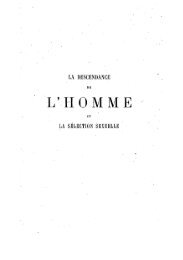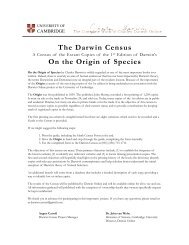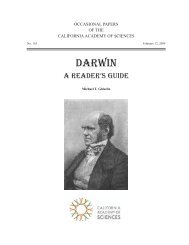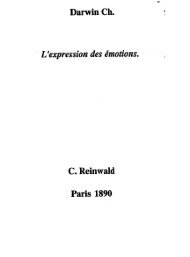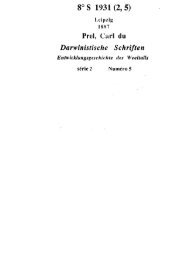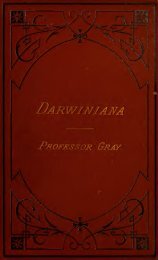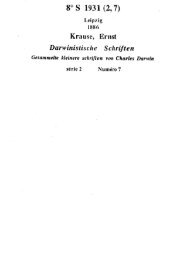Charles Darwin's Cambridge Life 1828-1831 - The Complete Work ...
Charles Darwin's Cambridge Life 1828-1831 - The Complete Work ...
Charles Darwin's Cambridge Life 1828-1831 - The Complete Work ...
You also want an ePaper? Increase the reach of your titles
YUMPU automatically turns print PDFs into web optimized ePapers that Google loves.
Journal of <strong>Cambridge</strong> Studies<br />
4<br />
1: 223) “What pleasant hours, those were when I used to come & drink coffee with you daily!”<br />
(Correspondence, vol. 7: 196)<br />
It was apparently Fox who inspired Darwin to embrace the scientific hobby of collecting insects,<br />
especially beetles. Darwin was soon scouring the surrounding fields and fens for rare species. After<br />
fifty years Darwin’s <strong>Cambridge</strong> friend Frederick Watkins (1808-1888), at Emmanuel College, could<br />
still remember Darwin’s enthusiasm for Panagaeus cruxmajor, or the crucifix ground beetle, one of<br />
<strong>Darwin's</strong> favourites. It occurs in Wicken and other fens under sedge litter. Darwin later recalled in<br />
his Autobiography, p. 63, “I am surprised what an indelible impression many of the beetles which I<br />
caught at <strong>Cambridge</strong> have left on my mind. I can remember the exact appearance of certain posts,<br />
old trees and banks where I made a good capture. <strong>The</strong> pretty Panagaus crux-major was a treasure in<br />
those days”. Darwin’s notes in his copy of Stephens 1829, p. 13, record his capture of one: “Cam:<br />
Spring <strong>1828</strong>”. In June <strong>1828</strong> Darwin reported excitedly to Fox “I Have taken Clivina Collaris, fig 3<br />
Plate III of Stephens”. Herbert recounted how one of the beetles was examined: “One day in his<br />
rooms he doped a large Beetle with a penful of prussic acid. <strong>The</strong> creature almost instantaneously<br />
kicked & fell over on his back apparently dead — but after a few minutes exposure to the lense it<br />
rallied and wattled off as if nothing had happened to it, to our general amazement.” (Herbert 1882)<br />
[Figure 1]<br />
Figure 1<br />
Darwin returned home to Shrewsbury for the summer. He visited friends and relatives for shooting<br />
and beetling. On 1 July <strong>1828</strong> Darwin set out for Barmouth, Wales for what he called his “Entomo-<br />
Mathematical expedition” a study holiday with a few other <strong>Cambridge</strong> undergraduates and their<br />
private tutors. Darwin’s mathematical tutor was George Ash Butterton (1805-1891) of St. John’s.<br />
Darwin spent most of his time in Barmouth with two particular friends, Herbert and Thomas Butler<br />
(1806-1886), the son of the headmaster of Shrewsbury School. What the tutor did while Darwin<br />
scrambled over mountains and popped beetles into bottles is not recorded. Herbert later described<br />
Darwin’s activities.<br />
On 27 August Darwin left Barmouth early for the start of the shooting season on 1 September. He<br />
returned to <strong>Cambridge</strong> for the Michaelmas Term on 31 October <strong>1828</strong>. Finally, there was a free room<br />
in College and the Tutor assigned Darwin to a comfortable set on the south side of First Court. <strong>The</strong>re



![[180] XXX. Notes on the Eflécts produced by 25720 Ancient Glaciers](https://img.yumpu.com/49145077/1/144x260/180-xxx-notes-on-the-eflects-produced-by-25720-ancient-glaciers.jpg?quality=85)
